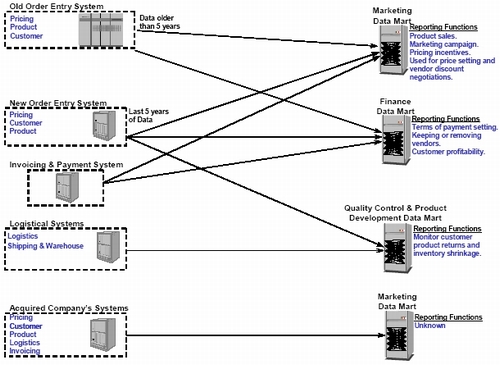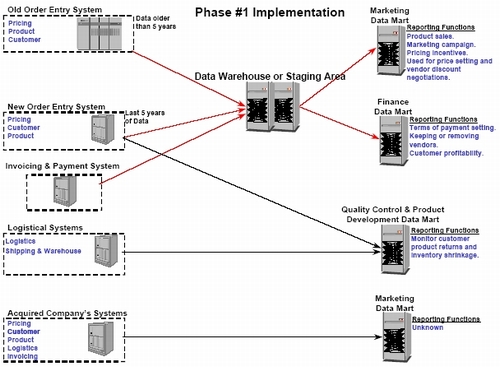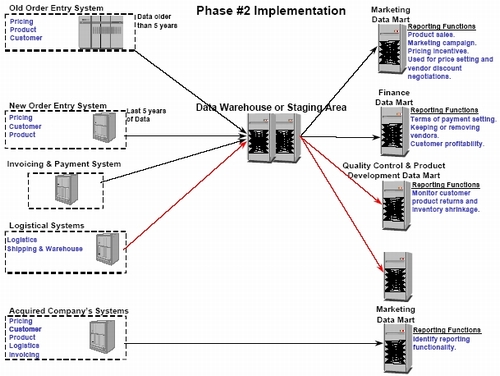“Independent” Data Marts: Being Stranded on Islands of Data – Part 3
By David Marco
Independent data marts have spread like a disease through many of today’s best and most advanced corporations. The devastating nature of this disease is that it is not easily detected in its initial stages, however if it is not treated that patient’s condition will steadily deteriorate.
This column is the third and concluding portion of a three part series on migrating from independent data marts. In parts one and two we examined the characteristics of independent data marts, the flaws in their architecture, the reasons why they exist, approaches for migration, initial planning and how to identify a migration path. In this month’s column I will present a case study illustrating how a corporation can migrate from independent data marts to an architected data warehousing solution.
Case Study: Putting the Concepts into Motion
The following case study looks to put the concepts we’ve discussed into action. This case study illustrates the iterative approach to independent data mart migration as most companies that have independent data marts typically have a pervasive and complexed situation.
Background
The Surefire Electronics Company is a Fortune 500 consumer electronics firm. Surefire Electronics recently acquired a smaller company (Small Guys Electronics) that has a single Marketing data mart which little is known about. In addition, Surefire Electronics is standardizing on a new order entry system within 5 years and existing batch windows for the legacy systems have reached their limit. Surefire Electronics’ management team is stable, well organized, and fully supports the migration effort. Table 1 lists out Surefire Electronics’ specific data warehousing details and Figure 1 shows their independent data mart architecture.

Table 1: Example Background

Figure 1: Independent Data Mart Architecture
Phase One Migration
By viewing the data, within each of the data marts, it is evident that the Marketing and Finance data marts share two common data sources (old and new order entry systems). In addition, the Marketing data mart has a strong end-user community that will be highly supportive of the migration effort. In addition, with a little bit of help from our executive management, both the Marketing and Finance data mart’s business users have agreed to freeze their additional functionality requests for Phase One of the migration.
During this phase we avoided migrating the Quality Control and the Small Guys Marketing data marts. This decision was made because of the lack of support in the Quality Control mart and all the “unknowns” of the Small Guys Marketing mart. Figure 2 illustrates the Phase One data warehousing architecture.

Figure 2: Phase One Data Warehousing Architecture
Phase Two Migration
The development effort that occurred in Phase One should illustrate the value of having an enterprise data warehouse. Our data warehousing team can now capture the amount of data that no longer requires storage since detailed data is stored in one spot and that the number of technical processes has been reduced. With this information in hand the data warehousing team can embark on Phase Two.
During this phase the logistics operational system’s data will be brought into the data warehouse and the Quality Control data mart is now being sourced directly from the enterprise data warehouse. In addition, during this phase the Marketing and Finance teams change requests that were frozen during Phase One implementation are now being developed. Lastly, a new dependent Accounting data mart is now being sourced from the data warehouse (see Figure 3).

Figure 3: Phase Two Data Warehousing Architecture
Phase Three Migration
In this phase we examine the functions and features of the Small Guys Electronics data mart. After this examination we find that the end users data needs are very similar to those needs of the current Marketing data mart. Therefore, Phase Three will consist of merging the functionality in the former Small Guys Electronics Marketing data mart into the existing dependent Marketing data mart and the addition of a new data mart (CEO data mart, see Figure 4).

Figure 4: Phase Three Data Warehousing Architecture
It is important to understand that the process for migrating off of this architecture is a costly proposition that will only get more expensive and difficult as time goes on. Remember, as with any disease the earlier it is detected and treatment begins the sooner the patient will become healthy. However if treatment is delayed the patient’s condition will worsen and eventually become terminal.